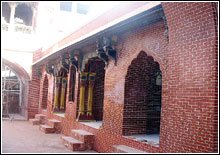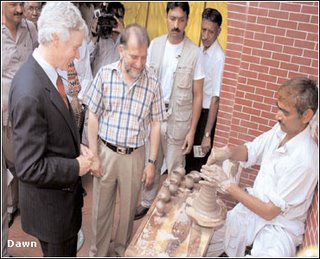Rural Tourism
Saturday, July 31, 2010
Tourists, visitors an travelers, for example to the Punjabi village Thatta Ghulamka Dhiroka are best recommended to leave back their city ideas and thereby become more open for understanding the rural life and its rich, traditional culture. If the come with urban attitudes, the visitors will start pitying the village dwellers for the deficient possibilities. Currently the villagers there do not need gymnastic studios like the city dwellers, the dusty path from one village to another is sufficient for walking practice instead of taking rounds in an oval stadium, and so on.
The so-called conveniences of city life must be financed. The drainage water must be disposed of somewhere, cultural and other institutions must be filled with life.
While making a journey to a village, one should leave behind expectations of necessities of life, like multiple course meals, air-conditioned rooms, luxurious bathrooms, swimming pools, the list goes on because with such fixed ideas one cannot learn anything about the culture in the rural areas.
We have already reported on the tragedy of the traditional culture, -- the absence of assessment possibilities of the economic impact only when the traditional values do not exist any more. Do we give them the due value which is at that point of time is probably too late?
An eventual help here is the reference to the increasing environmental sensitivities in populations in industrialized countries. The protection of the nature, the earth, the water is a luxury, which must be financed very expensively, with the side effect that one is not able to compete with countries that over exploit their resources.
Should good sense prevail, and sensible people should ask themselves why the whole expenditure? Reference is made here to “Max Weber” and his work “Protestant Ethic and the Spirit of Capitalism.”
Labels: Rural Tourism
posted by S A J Shirazi @ 9:24 AM,
,
![]()
![]()
Handicraft - Men Center - AFA

New handicraft are produced in Men Centre of AFA at TGD. Air Glider is another tiny winy toy manufactured by Zephanja from October 2007 to January 2008.


Readers of this blog remember the tin Rikshaw (toy) that is still very famous in gift market.
Labels: Appropriate Technology
posted by S A J Shirazi @ 8:34 AM,
,
![]()
![]()
Dolls Village Internet Radio
Monday, July 26, 2010

(Click to enlarge)
Labels: Internet Radio
posted by S A J Shirazi @ 10:42 AM,
,
![]()
![]()
In the village
Wednesday, July 21, 2010
Labels: Rural Areas, Rural Culture
posted by S A J Shirazi @ 3:41 PM,
,
![]()
![]()
Heritage Restoration
Monday, July 19, 2010
 According to an archaeology department official, the restoration has been carried out on the pattern it is constructed. "It has been brought to its original form," he adds. Moreover, the department maintains that it will rent out its (craft bazaar) shops to wood-workers so that they can display their artesan work.
According to an archaeology department official, the restoration has been carried out on the pattern it is constructed. "It has been brought to its original form," he adds. Moreover, the department maintains that it will rent out its (craft bazaar) shops to wood-workers so that they can display their artesan work.Located in a thickly populated area of Dehli Gate, in the walled city, it is one of the two most spacious mosques in Lahore. It reflects a blend of Persian and Indian styles of architectures.

Chiniot-born Hakeem Aleemuddin Ansari, known as Nawab Wazir Khan, had laid its foundation stone in 1634 and its construction was completed in 1635. It had been built with bricks and tiles and was entirely covered with arabesque painting and lacquered tiles. The inlaid pottery decorations and panelling of the walls were vivid and glowing.
The panels of pottery were set in hard mortar and flowers, with trees and goblets decorating the exterior of the walls.The plinth level was a storey higher than the ground. The facade of the main entrance of this imposing structure from the eastern side is laid with glazed tiles, which have numerous inscriptions of the Kalima going up to the ceiling in Kashikari.
Two wells had been dug to draw fresh water to fill the pond at the centre of the courtyard. Only one of them is functioning now.

Text and photographs by Zulquernain Tahir
Labels: Heritage
posted by S A J Shirazi @ 8:23 AM,
,
![]()
![]()
Arround Dolls' Village
Sunday, July 18, 2010
The murals are painted on the parameter mud walls in the village where doll collectors and people interested in sustainable development and rural heritage from different initiative groups come and stay as paying guests. The village folks still consider cooing crows as symbol of the arrival of the guests. Architectural competitions are held annually when best mud house is selected. The Chief Harappan Explorer Dr. Mark Kenoyer had the place on the jury in competition held last July. Two full time German volunteers, Dr Norbert Pintsch and Dr Senta Siller, and village people are working together to change the life and out look in this peaceful hamlet. Whenever I visited the village, I saw something new, something different, which the villagers do to make difference in a place where they belong.
Labels: Travel
posted by S A J Shirazi @ 5:57 PM,
,
![]()
![]()
Thatta Kedona: The Toy Village of Pakistan
Labels: Thatta Kedona
posted by S A J Shirazi @ 1:56 PM,
,
![]()
![]()
Russian Dolls
Saturday, July 17, 2010

Labels: Dolls of the World
posted by S A J Shirazi @ 7:13 AM,
,
![]()
![]()
Greenland Dolls Project
Thursday, July 15, 2010
Labels: Dolls of the World
posted by S A J Shirazi @ 10:31 PM,
,
![]()
![]()
Husain Qazi in TGD
Monday, July 12, 2010
 SAJ Shirazi's article Dolly good (appeared in Dawn) opened up a basket of sweet memories and took me back in year 2000 when someone told me about a doll village apparently belonging to the fairyland. So strong was the impact of narration that I was soon in that village which was surely more than my expectations, a classic example of a dream coming true by vision, determination and action.
SAJ Shirazi's article Dolly good (appeared in Dawn) opened up a basket of sweet memories and took me back in year 2000 when someone told me about a doll village apparently belonging to the fairyland. So strong was the impact of narration that I was soon in that village which was surely more than my expectations, a classic example of a dream coming true by vision, determination and action. The village farmers were trained in modern agri methods resulting in immense growth of agriculture, health and sanitation standards improved, the village school was revamped, massive tree plantation was carried out, a vocational centre was established for the training and skill development of village folks and of course the dolls and a host of other crafts are being produced and sold in and out of the country.
Labels: Dolls Village
posted by S A J Shirazi @ 9:12 AM,
,
![]()
![]()
Craft Bazaar
Thursday, July 8, 2010

Craft bazaar at the Wazir Khan mosque Lahore (Pakistan) opens.
Labels: Handicrafts
posted by S A J Shirazi @ 6:12 PM,
,
![]()
![]()
Have Been to Pakistan House Postdam, Germany?
Complete List is here
Labels: Volunteers
posted by S A J Shirazi @ 12:29 PM,
,
![]()
![]()
How lo Love a Black Woman
Wednesday, July 7, 2010
You know how to love black woman? Find out here.
Labels: Black Women, Bloggers
posted by S A J Shirazi @ 8:50 AM,
,
![]()
![]()
Heritage Trail
Monday, July 5, 2010
The idea of the conservation of the Gogera Fort and turning into a monument not only for the foreigners who frequent this area but also for next generations has become one of the active concerns of the NGO. Norbert Pintsch, Volunteer Project Director Technology Transfer and Training Center for Men in TGD, an Architect by profession and social worker by choice is taking keen personal interest in this project.
Labels: Thatta Kedona
posted by S A J Shirazi @ 9:10 AM,
,
![]()
![]()
Dolls Village Honorable Guests
Friday, July 2, 2010
The NGO, which has now become part of an international NGO network, has received a Seal of Excellence for Handicraft 2007 from UNESCO for its handicraft dolls, however it is still important to develop new marketable products.
Labels: Monika Kuppler, Volunteers
posted by S A J Shirazi @ 10:00 AM,
,
![]()
![]()
Dolls of the World

Labels: Dolls of the World, Thatta Kedona
posted by S A J Shirazi @ 7:54 AM,
,
![]()
![]()
Be in Cameroon
Thursday, July 1, 2010
posted by S A J Shirazi @ 8:40 PM,
,
![]()
![]()




